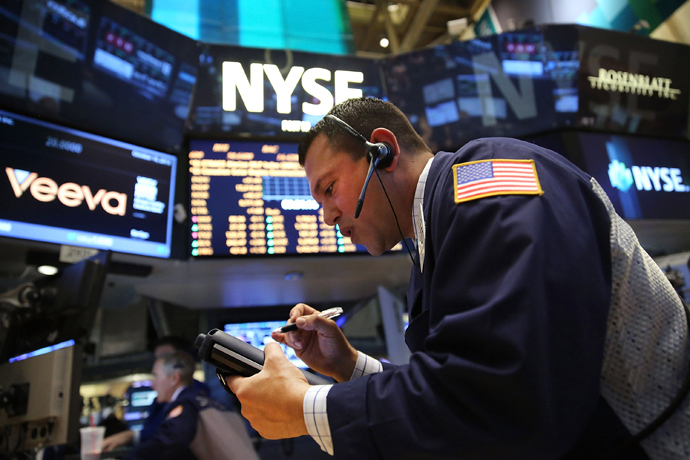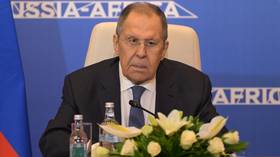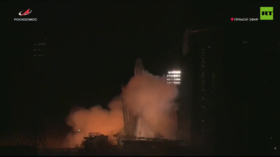Will China ‘de-Americanize’ the world?

The Beltway budget kabuki – aka shutdown – is over. But no ‘terrorist’ or dejected Hollywood screenwriter could have come up with a worse PR move and marketing strategy for brand USA.
Stocks won’t tank, interest rates won’t spike. We
will have no rising costs and no weaker US dollar – at least for
the next three months. Yes, because these are only stopgap measures.
Not to mention that the US’s biggest creditors – from China and
Japan to Brazil – would rather see Washington taking active steps
to clean up its horrendous financial act instead of just hiking
up the debt ceiling.
But this is not the key story. The key story is how Washington’s
paralysis was the straw that broke the dragon’s back; how it led
China to abandon its Deng Xiaoping maxim of carrying a low
profile, and start saying out loud what it really wants; a
radical change of the rules of the game.
The crucial exhibit is the by now famous Xinhua editorial calling
for a “de-Americanized” world.
Here, at Asia Times, I had a first shot at examining it.
So what does China really mean by ‘de-Americanizing’? For
starters, Beijing called the US credibility bluff as the leader
of the international financial system. Beijing was very much
aware of how the real ‘international community’
interpreted it. On one side the shutdown debacle. On the other
side, an economy growing 7.5 percent a year, with consecutive,
massive trade surpluses and over $3 trillion in foreign reserves.
Beijing’s offensive had been brewing for a while. It started with
Russian President Vladimir Putin (fully supported by China)
humbling US President Barack Obama and teaching him a diplomatic
lesson in the Syrian chemical weapons dossier.
It continued with Chinese President Xi Jinping’s wildly
successful tour of Central Asia, followed by another
successful tour of Southeast Asia, which included Xi as the sole
superstar at the APEC summit in Bali vis-à-vis no-show Obama.
Incidentally, in 1998, when the Asian financial crisis was still
raging, then-President Bill Clinton also skipped a visit to Asia.
This is what happened next; Asia turbocharged regional
cooperation, and slowly but surely China began to extend its
influence and trading power.
The crown in this new success story was Xi actively promoting – from Central Asia to Southeast Asia – a twin, overland and maritime, 21st-century Chinese version of the Silk Road.
Even the Washington Post was forced to wake up to a reality Asia Times had been reporting about for weeks, although, predictably, they totally missed the point, marketing the complex Chinese strategy as a response to former US Secretary of State Hillary Clinton’s ‘vision’. Howls of laughter could be detected in business centers from Shenzhen to Istanbul – as if a New Silk Road could possibly qualify as yet another product of American exceptionalism.

Feel free to bask in our connectivity
For all its immense internal problems and sociopolitical challenges, China also has every reason, long-term, to be on a high. This has everything to do with the productivity of 20 percent of mankind being unleashed wave after wave. The US underestimates Chinese resolve at its own peril. In 2012 China's GDP per capita was around $6,100 (compared with $50,000 for the US). Beijing will go no holds barred to quadruple it by 2020.
Imagine a country that in the foreseeable future remains the key node of the global supply and production chain – the Supreme Trading Power.
Imagine a country that by 2020 will have around 195 million university graduates – which is more than the entire US workforce.
Imagine a country engaged in the most astonishing urbanization process in the history of the world – yielding 221 new cities with over 1 million people each by 2025, most of them, of course, voracious consumers.
Imagine an Iron Silk Road – also known as the Third Eurasian land
bridge, a 15,000km high-speed rail network - linking the
southeast port of Shenzhen; Kunming, in southern Yunnan; and
Xinjiang, in western China, to Myanmar, Bangladesh, India,
Pakistan, Iran, Turkey and then all the way to the mega-port of
Rotterdam. That translates into China significantly less worried
about shipping across the Indian Ocean through the bottleneck of
the Strait of Malacca, which could one day be blocked by US
warships.
Imagine the Chinese-financed cousin of the Panama Canal; the $40
billion, 286km Nicaragua canal linking the Caribbean to the
Pacific.
Imagine the port of Lianyungang as the departure node for the
Second Eurasian land bridge linking China to Kazakhstan, Russia,
Belarus, Poland and then all the way to the juicy markets of the
European Union.
This is what the collective leadership in Beijing is imagining; the mega-connected largest economy in the world. And when that happens, new rules must apply.

Don’t take your eyes off the ‘petroyuan’
Make no mistake; the collective leadership in Beijing well knows
that a slow US decline has been an ongoing proposition since the
1973 oil shock – in parallel to the US dollar losing its value
since the US ended its tie to gold in 1971.
The corporate US response to the rising cost of labor in the West
plus automated mass production was to transfer practically the
whole American industrial base to China, thus multiplying its
profits (and in most cases paying for the delocalization through
tax breaks).
In the long run, Asia could not but win. Washington tried all
sorts of monetary scams to slow the decline. To no avail;
productivity kept falling in the West and rising in Asia.
And then the Federal Reserve kept printing paper like there’s no
tomorrow, buying bad debts from ‘too big to fail’ banks and US
Treasuries, and thus funding Washington’s ballooning spending.
Beijing still buys US dollars only because - for the moment –
this is the global reserve currency. Dollars are needed for the
oil trade. Beijing would rather spend its humongous stash on real
acquisitions, and not just US Treasury bonds.
Beijing’s game, in a nutshell, is to bypass the US dollar by all
means available. That’s the idea behind setting up currency swaps
with over 20 of its top trading partners – from BRICS countries
to African commodity producers and strategic energy partner Iran.
China is slowly but surely driving the progressive global flight
from the US dollar.
Washington’s mob tactics forcing the shady, corporate-concocted
Trans-Pacific Partnership (TPP) over Asian nations treated more
like subjects than partners also helps. As for the much-hyped
‘pivoting’ to Asia, most players – apart from Japan and
the Philippines – certainly see which way the geopolitical and
geo-economic wind is blowing.
In the Big Picture, there’s still no visible way out from casino
capitalism – featuring monopoly money and stock exchanges and
commodity prices totally controlled (and rigged) by computers.
Yet even the IMF has called for a new global financial
architecture. Beijing bets on an endgame of the US dollar as
reserve currency being replaced by a basket of currencies,
including the IMF mechanism of Special Drawing Rights (SDR).
At the same time Beijing – as well as Moscow - know that for the
system to change, it’s essential for a new reserve currency to be
totally backed by gold (or silver). So part of Beijing’s plan is
to accumulate gold by all means possible to back up the emerging,
convertible yuan. Of course this will take time. But Beijing has
been at it for five years now; the yuan may become fully
convertible as early as 2017.
The real game changer will happen when the petrodollar, essential for the awesome American military machine to be financed by the rest of the world, meets its match. That would imply the – for the moment unforeseeable – possibility of the House of Saud and other GCC petro-monarchies willing to embrace the petroyuan, as in China not having to use US dollars anymore to satisfy its energy thirst.
Only then we will be living in a ‘de-Americanized’ world.
And make no mistake: this is the desired endgame of China’s long
game.
The statements, views and opinions expressed in this column are solely those of the author and do not necessarily represent those of RT.
The statements, views and opinions expressed in this column are solely those of the author and do not necessarily represent those of RT.













